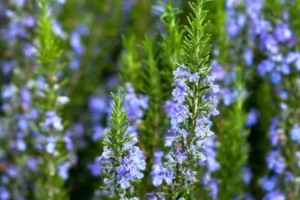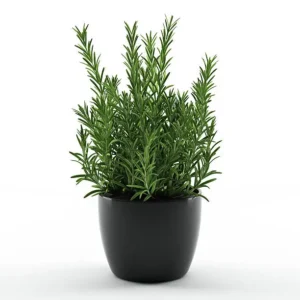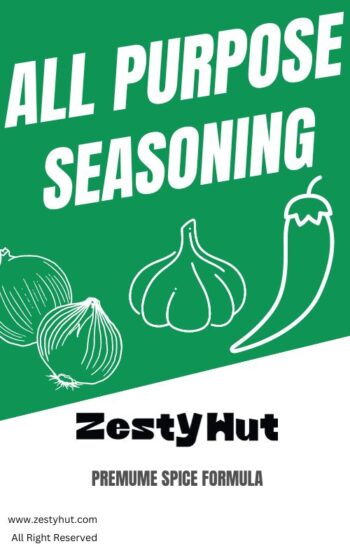Rosemary plants are renowned for their aromatic fragrance and culinary versatility with many rosemary varieties, each presenting unique characteristics for gardeners and culinary enthusiasts alike. Varieties of rosemary start from the robust leaves of Tuscan Blue to the delicate foliage of Prostrate, and the bold presence of Spice Islands, there are types of rosemary plants suit every preference.
Explore types of rosemary plants and the varied textures and colors, from the smoky aroma of Barbecue to the vibrant hues of Golden Rain, and enrich your garden with the enchanting allure of rosemary.
Types Of Rosemary Plants Based On Growth Appearance

- Upright Rosemary
Standing tall and proud, upright rosemary varieties have erect stems that grab attention. These plants make excellent focal points in herb gardens, formal hedges, and as standalone specimens in mixed borders. Varieties of rosemary like ‘Tuscan Blue’ and ‘Miss Jessup’s Upright’ demonstrate this elegant stature, offering vertical interest and architectural appeal to outdoor areas.
2. Compact Rosemary
This plant’s dense and bushy growth form produces compact mounds of aromatic leaves, making it suitable for smaller spaces, containers, and rock gardens. Their small size makes them ideal for edging pathways, defining borders, and adding texture to herbaceous borders. ‘Spice Islands’ and ‘Golden Rain’ are well-known for their compact growth habits and strong flavors, making them excellent additions.
3. Trailing Rosemary
Trailing rosemary varieties have a beautiful and charming appearance with their sprawling growth habit and delicate foliage that flows gracefully over walls, containers, and garden beds. ‘Huntington Carpet’ and ‘Cape Blanco’ are ideal for lending a touch of romance and nostalgia to gardens, patio containers, and hanging baskets, with their trailing elegance and cascading foliage.
- Dwarf Rosemary
These smaller kinds provide the same smell and flavor as larger varieties, making them ideal for small gardens, containers, and indoor planting. Dwarf rosemary plants are perfect for windowsills, containers, and balconies, where their compact growth habit and scented foliage may be appreciated up close. Varieties of rosemary like ‘Blue Boy’ and ‘Alcalde’ are known for their dwarf height and culinary excellence.
5. Groundcover Rosemary
Groundcover rosemary varieties have a low-growing and spreading growth habit, resulting in dense mats of aromatic leaf that effectively suppress weeds and control erosion. These plants are ideal for filling gaps between stepping stones, along garden walkways, or in rockeries, since they bring texture, color, and smell to the landscape. Types of rosemary plants like ‘Huntington Carpet’ and ‘Corsican Blue’ are prized for their ground-hugging habit and vigorous growth.
Types Of Rosemary Plants Based On Flower Color

- Blue Rosemary
Blue is a well-known color for rosemary flowers. Types of rosemary plants such as ‘Tuscan Blue’ and ‘Blue Spires’ have vibrant blue blossoms that offer an air of elegance and sophistication to any garden setting, making them popular among gardeners.
2. White Rosemary
White-flowered rosemary types offer a more quiet look. Rosemary varieties like ‘White Ice’ and ‘Albiflorus’ have beautiful white blossoms that reflect purity and beauty. These kinds are ideal for moon gardens or as highlights in mixed borders.
- Pink Rosemary
These types of rosemary plants add a gentle and romantic touch to garden landscapes. With their blush-hued blossoms, rosemary varieties like ‘Majorca Pink’ and ‘Pink Remembrance’ bring elegance and beauty to outdoor environments.
4. Purple Rosemary
Purple flowered rosemary species have a majestic appearance, providing romance and excitement to garden settings. Types of rosemary plants like ‘Roseus’ and ‘Benenden Blue’ have brightly colored blooms that provide a striking focal point in any environment.
I Know you want to know alot about rosemary plants You can read also : Rosemary Plant Overview
Types Of Rosemary Plants Based On Culinary Use
- Common Rosemary
With its needle-like leaves and woody stems, this rosemary variety is perfect for seasoning meats, poultry, and vegetables. Whether used fresh or dried, common rosemary adds depth and aroma to roasted dishes, marinades, and sauces. Its robust flavor profile makes it a favorite among chefs for infusing oils, vinegars, and dressings, elevating the simplest of dishes to gourmet status.
- Tuscan Blue Rosemary
With its powerful and savory flavor, Tuscan Blue is ideal for seasoning meats, chicken, and roasted vegetables. Its powerful aroma enhances the depth and richness of recipes, making it a Mediterranean staple.
3. Spice Islands Rosemary
With their strong and spicy flavor profile, the Spice Islands is ideal for complementing Mediterranean and Middle Eastern cuisine. Its aromatic presence gives depth and richness to herb blends, rubs, and marinades.
4. Barbecue Rosemary
Designed for grilling and smoking, Barbecue is another one of the rosemary varieties that infuses meats with a strong, smokey flavor. Its thick leaves and rich flavor make it a crucial ingredient for barbecue fans seeking to add depth and character to their recipes.
- Golden Rain Rosemary
With a citrusy taste, Golden Rain is a rosemary variety that enhances seafood, salads, and desserts with its fresh flavor. Its vivid aroma adds a burst of freshness to recipes, making it an adaptable addition to any cuisine.
How To Plant Rosemary

- Selecting the Perfect Location
The first step in planting rosemary is to choose the ideal place for your new herb garden. Rosemary grows in full sun and well-drained soil, so find a location that gets at least six to eight hours of sunlight per day and has adequate drainage. Rosemary prefers slightly sandy, well-aerated soil, therefore avoid places with hard clay soil or standing water.
2. Preparing Soil
Once you’ve decided on the best place for your rosemary garden, it’s time to prepare the soil. Begin by loosening the soil to a depth of at least 12 inches then breaking up any clumps and clearing any weeds and trash.
- Selecting the Right types of rosemary plants
When planting rosemary, it’s important to select the appropriate rosemary varieties for your yard. While common rosemary (Rosmarinus officinalis) is the most generally planted form, there are various rosemary varieties to pick from, each with its distinct qualities and culinary applications. Popular kinds include Tuscan Blue, Spice Islands, and Majorca Pink. When choosing varieties of rosemary for your garden, consider your climate, available area, and culinary preferences.
- Propagating Rosemary
There are various methods for propagating rosemary, including seeds, cuttings, and nursery-grown plants. Growing rosemary from seeds is possible, but it may be difficult and time-consuming, so most gardeners prefer to begin with nursery-grown plants or cuttings. If starting from cuttings, take healthy, non-flowering stems from an established rosemary plant and root them in a well-draining potting mix. Keep the soil moist but not watery, and plant the cuttings in a warm, sunny spot until roots develop. - Planting Rosemary
When your rosemary plants are ready for planting, place them in the ground. Dig a hole somewhat larger than the plant’s root ball, then gently loosen the roots before placing the plant in it. Backfill the hole with soil, making sure the plant is planted at the same depth as it was in the nursery pot. Water the newly planted rosemary thoroughly to settle the soil around the roots and eliminate air pockets.
How To Care Rosemary Plant
After planting, rosemary requires little maintenance, but there are a few important things to do. Water newly planted rosemary on a frequent basis until it establishes itself, then only during dry seasons or when the soil seems dry to touch. Overwatering is not recommended since rosemary roots decay easily in wet soil. Fertilize rosemary lightly with a balanced herb fertilizer, and prune on a regular basis to keep it in shape and encourage bushy growth.
How To Harvest Rosemary
To harvest your herb you should wait until rosemary plants are at least six to eight inches tall before harvesting, and don’t take more than one-third of the plant’s growth at once. To harvest rosemary, snip off the necessary amount of foliage with sharp scissors, being careful not to injure the stems or roots. Use fresh rosemary right away, or dry it for later use.
Conclusion
Whether used for gardening purposes to make the best out of its beautiful leaves and flowers or used for culinary purposes, the various types of rosemary plants come in many shades, each with its unique characteristics and flavor to serve our needs with full optimization.
FAQs:
- How many types of rosemary are there?
There are various types of rosemary, each with its distinct characteristics such as growth habits, foliage colors, flower colors, and culinary use. While exact numbers may differ depending on classification standards and geographical variances, common varieties include Tuscan Blue, Prostrate, Spice Islands, Barbecue, Golden Rain, Blue Boy, Irene, Arp, Corsican Blue, Miss Jessup’s Upright, and many others.
- Are all types of rosemary edible?
Yes, all types of rosemary are edible. However, it’s essential to ensure that any rosemary used for culinary purposes has not been treated with pesticides or other chemicals that may be harmful if ingested. As with any herb, moderation is key, and it’s always advisable to verify the safety of any plants used for consumption.
- Does rosemary like full sun or shade?
Rosemary prefers full sun. It thrives in locations with at least 6-8 hours of direct sunlight per day.
- How often should you water rosemary?
Depending on the temperature and soil conditions, this may require watering every 1-2 weeks during the growing season. However, in hot, dry weather or when grown in containers, rosemary may require more frequent watering. It is critical to keep track of the moisture level in the soil and manage the watering frequency accordingly to ensure that the plant’s needs are met without overwatering.
















